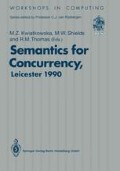Abstract
Labelled transition systems provide convenient models for many computational systems. Their usefulness is due partly to their natural association with temporal logics which may be used to express interesting properties of systems. It is of course vital to be able not only to express properties of programs but also to determine whether they hold of them. In the case of finite-state systems, much work has been done on automatic model checking [4]. Algorithms are known for a variety of logics, and many have been implemented and used to study systems including communications protocols and digital circuits.
Access this chapter
Tax calculation will be finalised at checkout
Purchases are for personal use only
Preview
Unable to display preview. Download preview PDF.
References
H. Barringer, R. Kuiper and A. Pnueli, Now You May Compose Temporal Logic Specifications, in Proc. 16th Symp. Theory of Comp. ACM Press, 1984.
J. Bradfield, Proving Temporal Properties of Petri Nets, to appear in Proc. of 11th International Conference on Applications and Theory of Petri Nets, Paris, June 1990.
J. Bradfield and C. Stirling, Verifying Temporal Properties of Procesees, submitted for publication.
E. Clarke, E. Emerson and A. Sistla Automatic Verification of Finite-State Systems Using Temporal Logic Specifications: a Practical Approachin Proc. 10th Annual ACM Symp. in Principles of Programming Languages, 1983.
E. Clarke and O. Grumberg The Model Checking Problem for Concurrent Systems With Many Simple Processesin Procs. Temporal Logic in Specification, eds. B. Banieqbal, H. Barringer and A. Pnueli, Springer LNCS 398, 1989.
E. Emerson and C.-L. Lei Efficient Model Checking in Fragments of the Propositional Mu-Calculusin Proc. 1st IEEE Symp. on Logic in Computer Science, 1986.
E. Emerson and J. Srinivasan, Branching Time Temporal Logic, in Proc. Workshop on Linear Time, Branching Time and Partial Order in Logics and Models for Concurrency, eds. J. de Bakker, W.-P. de Roever and G. Rozenberg, Springer LNCS 354, 198Q.
D. Knuth, Additional Comments on a Problem in Concurrent Program Control, Comm. ACM, 9/5 1966.
D. Kozen, Results on the Propositional p-calculus, Theoretical Computer Science, 27 1983.
K. Larsen, Proof Systems for Hennessy-Milner Logic with Recursion,to appear in Information and Computation.
Z. Manna and A. Pnueli, The Anchored Version of the Temporal Framework, in Proc. Workshop on Linear Time, Branching Time and Partial Order in Logics and Models for Concurrency, eds. J. de Bakker, W.-P. de Roever and G. Rozenberg, Springer LNCS 354, 1989.
M. Pease, R. Shostak and L. Lamport, Reaching Agreement in the Presence of Faults, Journal ACM, 27 1980.
G. Plotkin, A Structural Approach to Operational Semantics, Technical Report DAIMI FN-19, University of Aarhus 1981.
V. Pratt, A Decidable Mu-Calculus, in Proc. 22nd IEEE Foundations of Computer Science, 1981.
C. Stirling, A Generalization of Owicki-Gries’s Hoare Logic for a Concurrent While Language, Theoretical Computer Science 58 (1988).
C. Stirling, Modal and Temporal Logics, chapter to appear in Handbook of Logic in Computer Science, OUP 1990.
C. Stirling and D. Walker, Local Model Checking in the Modal Mu-Calculus, in Proc. Intl. Joint Conf. on Theory and Practice of Software Development, eds. J. Diaz and F. Orejas, Springer LNCS 351, 1989.
D. Walker, Automated Analysis of Mutual Exclusion Algorithms Using CCS, Formal Aspects of Computing (1989) 1.
Author information
Authors and Affiliations
Rights and permissions
Copyright information
© 1990 Springer-Verlag Berlin Heidelberg
About this paper
Cite this paper
Stirling, C., Walker, D. (1990). A General Tableau Technique for Verifying Temporal Properties of Concurrent Programs. In: Semantics for Concurrency. Workshops in Computing. Springer, London. https://doi.org/10.1007/978-1-4471-3860-0_1
Download citation
DOI: https://doi.org/10.1007/978-1-4471-3860-0_1
Publisher Name: Springer, London
Print ISBN: 978-3-540-19625-9
Online ISBN: 978-1-4471-3860-0
eBook Packages: Springer Book Archive

